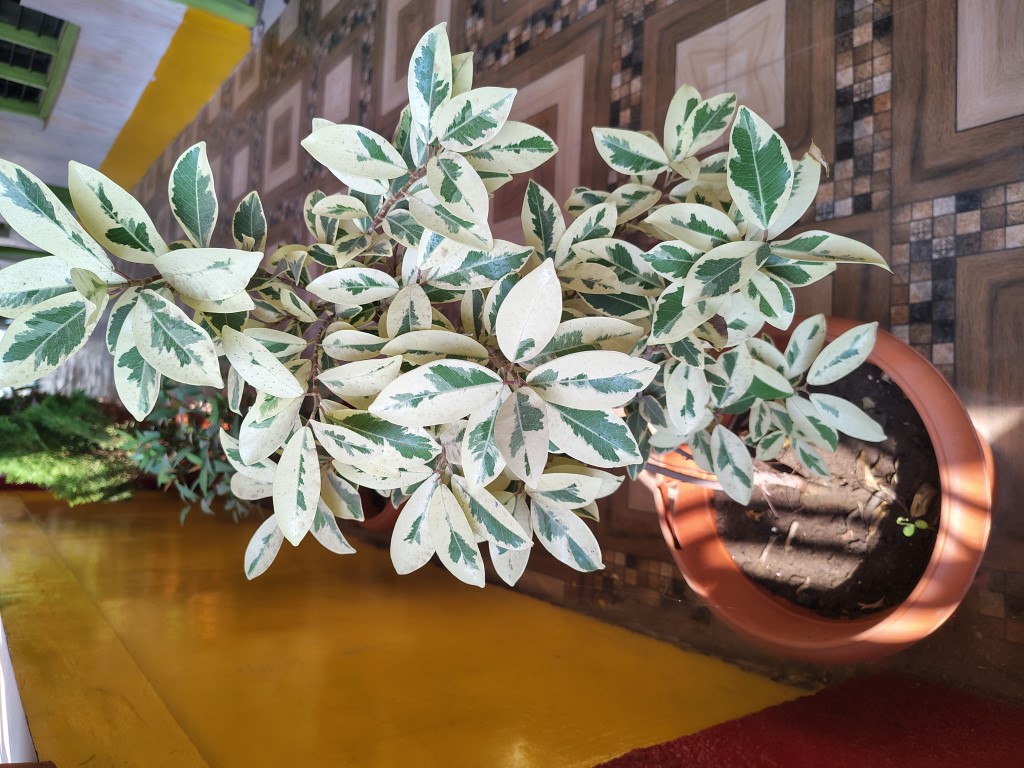Green Campus/Tree Details

चायनीज बानियन [Chinese Banyan ]
मुख्य वैशिष्ट्ये
-
वाढीचे स्वरूप:
- कुंडीत लावल्यास ३-६ फूट उंचीपर्यंत मर्यादित राहते.
- बाहेर लावल्यास हे झाड मोठे होऊन जाड, दाट फांद्या असलेल्या झाडामध्ये रूपांतरित होते.
-
पाने:
- अंडाकृती, चकचकीत, आणि आकर्षक हिरवी-पांढऱ्या रंगाची विविधरंगी पाने.
- सदाहरित स्वरूपाचे पान असल्याने झाड नेहमीच हिरवे दिसते.
-
फुले व फळे:
- लहान व साधी फुले येतात, जी लक्ष वेधून घेत नाहीत.
- छोटे गोलसर हिरवे फळ (अंजीर) येते, पण ही प्रक्रिया मुख्यतः बाहेर वाढणाऱ्या झाडांमध्ये होते.
-
मुळे:
- झाडाची मुळे मजबूत व जलद वाढणारी असतात.
- बाहेर लावल्यास मुळे खूप पसरतात, त्यामुळे घरांच्या जवळ लावताना काळजी घ्यावी.
हवामान व मातीसंबंधी मागण्या
-
प्रकाश:
- तेजस्वी, अप्रत्यक्ष सूर्यप्रकाश आवडतो.
- थोडासा सावलीत देखील चांगले वाढते.
-
माती:
- निचरा होणारी, सुपीक व योग्य प्रमाणात खत असलेली माती हवी.
- थोडीशी आम्लीय किंवा तटस्थ माती (pH 6–7) योग्य आहे.
-
पाणी:
- मध्यम प्रमाणात पाणी द्या; माती सुकल्यावरच परत पाणी द्या.
- जास्त पाणी दिल्यास मुळे कुजण्याचा धोका असतो.
-
तापमान:
- १८–३०°C तापमान झाडाच्या वाढीसाठी उत्तम आहे.
- थंड हवामानात झाडावर विपरीत परिणाम होतो.
-
आर्द्रता (ह्युमिडिटी):
- मध्यम ते जास्त आर्द्रता आवश्यक आहे.
- घरात ठेवल्यास, पानांवर पाणी फवारणी (मिस्टिंग) करावी.
देखभाल मार्गदर्शन
-
खते:
- वसंत व उन्हाळ्याच्या हंगामात (मार्च-ऑक्टोबर) १५-२० दिवसांनी द्रवरूप खत द्यावे.
- हिवाळ्यात खत कमी द्यावे.
-
छाटणी (Pruning):
- वेळोवेळी छाटणी केल्यास झाडाला हवे तसे आकार देता येतो.
- बोन्साय तयार करण्यासाठी योग्य.
-
कीड व रोग व्यवस्थापन:
- सामान्य किडी: कोळी, मेलीबग, व स्केल कीड. यासाठी नीम तेल किंवा जैविक कीटकनाशक वापरावे.
- जास्त पाणी दिल्यास मुळे कुजतात व पाने गळू लागतात.
उपयोग व फायदे
-
सौंदर्य वाढवण्यासाठी:
- विविधरंगी पानांमुळे घर, बाग, आणि कार्यालयाला आकर्षक लूक मिळतो.
- बोन्साय तयार करण्यासाठी खूप लोकप्रिय.
-
हवेची शुद्धता:
- कार्बन डायऑक्साईड, फॉर्मल्डिहाइड यांसारखे हवेतील विषारी घटक शोषून हवा शुद्ध करते.
-
भूसंरक्षण:
- मजबूत मुळे मातीची धूप रोखण्यासाठी उपयुक्त.
-
सांस्कृतिक महत्त्व:
- काही ठिकाणी फिकस प्रजातीचे झाड शुभ मानले जाते आणि समृद्धीचे प्रतीक आहे.
प्रसार (Propagation)
-
काट्यांपासून प्रसार:
- ४-६ इंच लांब काडी घेऊन, ती मोकळ्या निचरा होणाऱ्या मातीत लावा.
- मुळे तयार झाल्यावर, ती मोठ्या कुंडीत किंवा जमिनीत लावा.
-
हवेच्या लेअरिंगद्वारे (Air Layering):
- झाडाचा एक फांदीवर मुळे येण्यासाठी प्रक्रिया केली जाते, व ती फांदी नंतर स्वतंत्र झाड म्हणून लावली जाते
Key Characteristics
-
Growth Habit:
- Grows as a medium-sized tree in the wild, but as a compact shrub or bonsai indoors.
- When grown in pots, it remains small, typically reaching a height of 3–6 feet.
- Outdoors, it can grow into a large tree with dense foliage.
-
Leaves:
- Oval-shaped, glossy, and variegated with distinct green and white patterns.
- The leaves are smooth and evergreen, adding a decorative look to indoor or outdoor spaces.
-
Flowers and Fruits:
- Produces small, inconspicuous flowers and tiny green fruits (figs).
- Fruiting is more common when the plant is grown outdoors in its native climate.
-
Roots:
- A strong root system, making it suitable for bonsai or erosion control.
- Care should be taken when planting near buildings as roots can spread extensively outdoors.
-
Environmental Requirements
-
Sunlight:
- Thrives in bright, indirect sunlight; can tolerate partial shade.
- Avoid direct harsh sunlight, which may scorch the variegated leaves.
-
Soil:
- Prefers well-draining soil with a mix of garden soil, sand, and compost.
- The plant is adaptable but thrives in nutrient-rich, slightly acidic to neutral soil (pH 6–7).
-
Watering:
- Moderate watering is required. Allow the top layer of soil to dry before watering again.
- Overwatering can lead to root rot.
-
Temperature:
- Prefers a warm climate (18–30°C).
- Sensitive to frost and extreme cold temperatures.
-
Humidity:
- Grows well in moderate to high humidity.
- Mist the plant occasionally to maintain humidity levels, especially indoors.
-
Care Tips
-
Fertilization:
- Apply a balanced liquid fertilizer every two weeks during the growing season (spring and summer).
- Reduce feeding in the dormant season (winter).
-
Pruning:
- Regular pruning helps maintain shape and encourages healthy growth.
- Ideal for bonsai creation as it responds well to pruning and shaping.
-
Pest and Disease Management:
- Common pests include spider mites, mealybugs, and scale insects. Use neem oil or insecticidal soap for treatment.
- Overwatering can cause fungal diseases; ensure proper drainage.
-
Uses and Benefits
-
Aesthetic Value:
- Popular as a decorative plant for homes, offices, and gardens due to its striking foliage.
- Suitable for bonsai art, adding a touch of greenery to small spaces.
-
Air Purification:
- Known to absorb toxins like carbon dioxide and formaldehyde, improving indoor air quality.
-
Landscaping:
- Used in outdoor landscapes for hedges and erosion control due to its dense growth and robust roots.
-
Cultural Significance:
- In some cultures, Ficus species are symbolic of prosperity and good fortune.
-
Propagation
-
Stem Cuttings:
- Take a 4–6 inch cutting with a few leaves attached.
- Plant it in moist, well-draining soil or water until roots develop.
- Transplant into a pot once the roots are well-established.
-
Air Layering:
- A branch is encouraged to root while still attached to the parent plant. This method ensures successful propagation
- झाडाचा एक फांदीवर मुळे येण्यासाठी प्रक्रिया केली जाते, व ती फांदी नंतर स्वतंत्र झाड म्हणून लावली जाते
